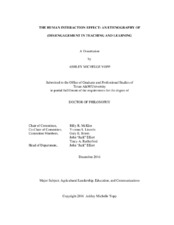| dc.description.abstract | Educators and students struggle with engagement in many educational settings and at all levels. A lack of engagement has been reported to contribute to an ever-widening gap between how students develop knowledge, skills, and abilities and how teachers provide instruction. At the onset of this study, the purpose was to understand how depth and sequence of experience influenced student engagement. During one calendar year, 42 undergraduate students between 18-25 years of age enrolled in an applied social science research methods course and agreed to participate in this study. Students enrolled in one or two of three academic semesters (spring, summer, and fall) with varying depths and sequences of experiences. I collected data through student interviews, observations, student and teacher reflexive journals, and classroom dialogues. Additionally, I considered aspects of students’ critical thinking abilities, personalities, and learning styles throughout the duration of the study. Results of this study included narrative themes that described the complex and unforeseen realities of (dis)engagement experienced by teachers and students. Conclusions included that all levels and sequences of experiences were engaging, but not all experiences were equally engaging. Further, I noted the environment to have a profound effect on the implementation of the depth and sequence of experiences: The design of the experiences was conceptualized for an in vitro environment, yet the experiences were carried out in an in vivo environment. Various perspectives of experiences existed, and individuals’ temporal, physical, and emotional proximity to specific experiences often influenced other students’ and teachers’ perspectives. At the conclusion of the study, it was evident that the scope of the study needed to be expanded beyond the influence of how depth and sequence of experience engaged and disengaged students and teachers. Although many researchers have proposed models for experiential teaching and learning, few have accounted for the abstract and malleable nature of models and rarely include the influence of temporal stability on (dis)engagement. | en |


